| |
The
Irish Clerical "Republic" was Founded by 2 British Spies!! |
|
| |
The
British Empire Irish "Republic" exposed at last!! |
|
In
the 20th century, at least 5 states were created by Gog and Magog. They
were: Irish clerical "Republic", Nazi Germany, Saudi Arabia,
the Crusader state of "Israel" and the Islamic "Republic"
of Iran. Unfortunately, only one of these states (Nazi Germany) has
disappeared from history,
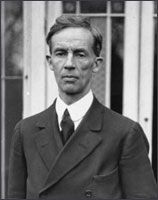
Erskine Childers
(1870 1922). |
| |
It is beyond
belief but the Irish clerical "Republic"
was founded by 2 British spies.
A
true Republic next door to an absolute monarchy
is as impossible as mixing iron and clay (Daniel Chapter
2).
|
|
|
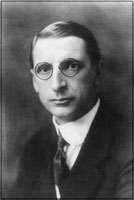
Éamon de Valera
(1882–1975). |
Eskine
Childers was the quintessential upper class Englishman.....Public
school (private school) at age 10, and then Trinity College, Cambridge.
He was a super-patriotic British imperialist . . . and the co-founder
of the Irish clerical "Republic."
He
was the forerunner of the Ayatollah Khomeini and the "Republic"
he had in mind was not a "government of the people, by the people,
and for the people," but a clerical "Republic run by the Latin
hierarchy!
A real
Republic like the United States is the BEST form of government because
nobody should be ruled by another without his/her consent.
Ancient Israel was a Republic for the first 500 years until the people
rebelled and asked JEHOVAH to give them a king.
The
great weakness of a Republic and a free society is the fact that despicable
spies can very easily infiltrate and destroy it from within. Once
a Republic becomes involved in foreign wars, that is a sure recipe for
its destruction. Ancient Rome was a Republic until Julius Caesar began
the conquest of Gaul . . . and that led to the downfall of that Republic.
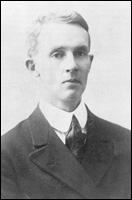
Erskine Childers circa 1900. |
| |
Erskine
was a gung-ho British "patriot" who volunteered
to fight the 2 Christian Dutch Republics of South
Africa in
order to steal their gold and diamonds!!
He
was an ardent imperialist who hated Republics and
believed wholeheartedly in the British monarchy.
He
was also the co-founder of the Irish clerical "Republic." |
|
|
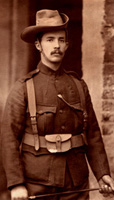
Childers as a Boer
War soldier. |
If he was alive
in 1812 he would be the first to volunteer to fight the newly created
United States. By that time (1899), Queen Victoria—who hated
foreign wars since the death of her beloved German husband—was
too old the restrain her subjects.
To his great
disappointment, Childers did not kill any Christian Boer farmers
and return rich with diamonds
and gold. His short career in the army was mediocre.
After returning
from the war, he decided to become an author and expose the "German
threat" to the British North Sea fleet. After the Boer War, no
country in the world (especially Germany) had the remotest possibility
of challenging the might of the British Empire.
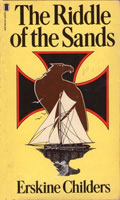
The 1903 Riddle of the Sands. |
| |
The
Germans are coming, the Germans are coming!!
Erskine's
1903 book was the first spy novel to expose the "German
threat."
The
Kaiser had just told the Boer farmers that he had no navy
so he couldn't render them any assistance.
|
|
|
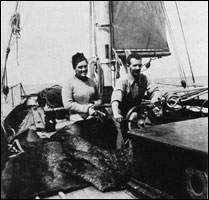
Erskine and his wife Molly
on a Baltic cruise. |
Childers
was the forerunner of MI6 spy William Le Queux.
Before
joining the British army, Childers bought a yacht and took a long cruise
to the Frisian Islands. His book was based upon that voyage and he claimed
that the Germans were secretly building up their navy to challenge British
maritime supremacy!!
Naturally,
it caused a sensation like the later Le Queux books. Here is an excerpt
from that fear mongering book.
"I
start with two certainties," he said. "One is that I was
'moved on' from that coast, because I was too inquisitive. The other
is that Dollmann is at some devil's work there which is worth finding
out. Now"–he paused in a gasping effort to be logical and
articulate. "Now—well, look at the chart. No, better still,
look first at this map of Germany. It's on a small scale, and you
can see the whole thing." He snatched down a pocket-map from
the shelf and unfolded it. "Here's this huge empire, stretching
half over central Europe–an empire growing like wildfire, I
believe, in people, and wealth, and everything. They've licked the
French, and the Austrians, and are the greatest military power in
Europe. I wish I knew more about all that, but what I'm concerned
with is their sea-power. It's a new thing with them, but it's going
strong, and that Emperor of theirs is running it for all it's worth.
He's a splendid chap, and anyone can see he's right. They've got no
colonies to speak of, and must have them, like us. They can't get
them and keep them, and they can't protect their huge commerce without
naval strength. The command of the sea is the thing nowadays, isn't
it? I say, don't think these are my ideas," he added, naively.
"It's all out of Mahan and those fellows. Well, the Germans have
got a small fleet at present, but it's a thundering good one, and
they're building hard. (Childers, Riddle
of the Sands, pp. 86-87).
By 1914, Ireland was
ready for Home Rule and a Home Rule bill had passed Parliament.
It might not have satisfied everybody but it was a start to the
search for a peaceful solution to the problems of
that troubled land.
The Irish Parliament
was abolished in 1800 and moved to Westminster. This abolition of
the Irish Parliament was engineered by another British spy named
William Wickham.
A
British spy helped abolish the Irish Parliament in 1800!!
In
465 AD, the great Saint Patrick died
and went to his eternal reward in Heaven.
In 1155, English
Pope Adrian IV donated Hibernia to King Henry II of England. The
Pope claimed as his authority for doing so the forged Donation of
Constantine. Henry's title was LORD of Ireland, while the Pope was
the de facto KING of Ireland.
Up to that time,
Christianity in Ireland had no connection whatsoever with Papal
Rome. Irish Christians used the old Latin Itala Version of the Bible,
and their date for Passover/Resurrection was the full moon Jewish
Passover.
In 1542, the
Parliament of Ireland, under the Crown of Ireland Act, granted King
Henry VIII and his successors the title King of Ireland. The corrupt
monasteries were suppressed by the Parliaments in England and Ireland.
At that time,
the Hibernians were fearful of a Spanish invasion and they
looked to England as a big brother to protect them!
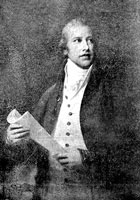
William Wickham (1761–1840) from
a portrait painted in Vienna in 1801. |
| |
Master
spy Wickham was sent to France in 1795 to work closely
with fellow agent Napoleon Bonaparte.
Wickham
was determined to have the young Republic invade Ireland.
This
invasion would be the pretext for the abolition of the
Irish Parliament. |
|
|
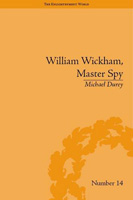
Recent biography of
William Wickham, master spy. |
Master
spy Wickham was also stationed in Switzerland and Austria. He worked
closely with the Austrians to affect the destruction of the French
Republic:
The
ideal Austrian strategy from the British government's point of view
was a two-front invasion, one from the lower Rhine into Franche-Comté
and the other from the Alpine region into Savoy, the latter using
a combined Austro-Sardinian force under an Austrian commander. Throughout
the summer Wickham waited on tenterhooks, and in vain, for the Austrians
to move, as conflicting reports of their intentions came to him.
The pincer movement desired by Wickham never had any chance of success,
for on both prospective battlefronts the Austrian generals showed
little enthusiasm to move into France. In the south, General Joseph
De Vins preferred the safer option of an invasion of the Riviera
coast in the direction of Toulon, protected by the British fleet,
to an advance into Savoy. This strategy failed to threaten the French
interior, left Lyon without protection and effectively ended any
hopes Wickham had of continued cooperation with the Royalists in
the east. (Durey, William Wickham, p. 54.)
The
French Republic was later destroyed by Napoleon Bonaparte. Napoleon's
career mirrors that of Adolf Hitler. Both men invaded Russia on the
same date, and both men were given a comfortable retirement thanks
to the British government.
When
France became a Republic in 1792, the British saturated that
country with their spies in order to hasten its downfall. This
led to French intervention in Ireland and a bloody insurrection in
1798,
Monarchies
have always looked upon Republics as their deadly enemies. This was
particularly so with Great Britain which was one of the most powerful
monarchies in the world.
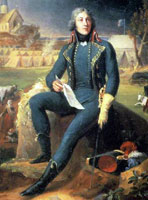
General
Lazare Hoche
(1768–1797),
|
| |
In
1796, British spy general Lazare Hoche tried to invade
Ireland with 15,000 soldiers.
The
last thing the French Republic needed to survive was foreign
intervention.
Lazare's
invasion attempt was a disaster. |
|
|
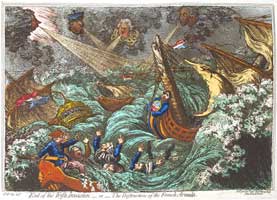
Destruction
of the French Armada
in 1796.
|
Ireland
was also saturated with British spies. No way could a small island
gain its independence by military force but the British had their
French spies ready to assist them!!
The
Irish insurrection of 1798
A deadly
insurrection took place in Ireland in 1798 and this bloody conflict
led to the abolition of the Irish Parliament 2 years later.
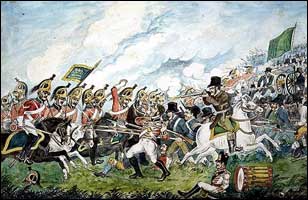
Battle
of Vinegar Hill in Co. Wexford. |
| |
A
deadly insurrection took place in Ireland in 1798.
With
help from the French, this sanguinary conflict lasted an
entire year.
When
it was over, the British government decided that Ireland
could no longer rule itself. |
|
|

Atrocity scene during the insurrection. |
Thousands
of men, women and children were killed in the year long bloody conflict.
When it was all over, Prime Minister William Pitt decided that the
Irish were no longer fit to rule themselves so he appointed his top
general to rule the island.
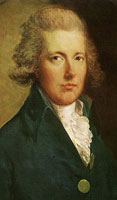
William Pitt (1758–1806).
Prime Minister from 1783 to 1801. |
| |
Due
to the 1798 insurrection, Prime Minister William
Pitt appointed Lord Cornwallis as Lord Lieutenant and commander-in-chief
of Ireland,
This
was the infamous Lord Cornwallis who "surrendered"
at Yorktown in 1781.
Cornwallis'
bayonets helped the Irish to pass the Act of
Union. |
|
|
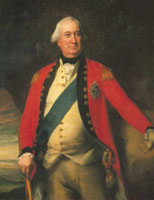
Lord Conwallis
(1738–1805). |
During
the debates on the Act of Union, William Wickham was very, very busy
trying to bribe all the Irish MP's:
The king's government had grown accustomed to a certain
informality of procedure in the pursuit of its objectives. The ruthlessness
cloaked within its foreign policy was here applied to Ireland, with
the involvement of William Wickham
as the common denominator. Ostensibly a mere under-secretary at
the home office, in reality Wickham was one of the most powerful
figures in Europe. From his important position in the alien office,
the department that coordinated and controlled British secret service
activity, Wickham was the financier of intelligence operations,
and directed espionage on the continent. Roger Wells has commented
that "secrecy, intrigue and conspiracy are the hallmarks of
politics in the nineties [1790s]." (Geoghegan, The Irish
Act of Union, p. 58).
In
the end, it was mostly the Latin Church members who "voted"
for the Union and the abolition of the Irish Parliament! After the
abolition of the Irish Parliament, that country suffered from malign
neglect.
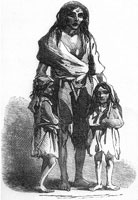
3 victims of the Irish potato famine. |
| |
After
the abolition of Parliament, Ireland suffered from malign
neglect.
A
great famine devastated the country from 1845 to 1852.
The
survivors emigrated en masse to the U.S., among
them the ancestors of President
Kennedy.
|
|
|

Famine Memorial in Dublin. |
The
Great Irish Famine was a boon to the Latin hierarchy because millions
of their dupes emigrated to the United States, Canada, and Australia.
Both of the ancestors of President Kennedy emigrated to the U.S. during
that time.
Erskine
Childers promoted another insurrection in 1916!!
The
1798 insurrection in Ireland led to the Act of Union and the abolition
of the Irish Parliament; the second insurrection led to the creation
of a clerical "Republic" under Éamon de Valera.
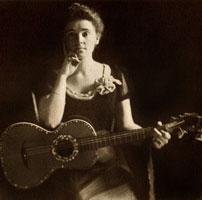
Molly Childers (1875–1964) was
a great help to her MI5 husband. |
| |
In 1914,
Erskine Childers led a major gun-running operation into
Ireland from his yacht Asgard.
He
was assisted by his wife Molly.
His
activities were watched carefully by the Royal Navy. |
|
|

Molly Childers and Mary Spring Rice with rifles aboard Asgard.
|
All
of the guns were purchased in Germany. The Bible tells us to give
ALMS to the needy . . . not ARMS:
On
27 May, 1914, Erskine and Darrell Figgis departed for the Continent
on a mission to buy guns. They travelled first to Liège,
then the principal centre for arms dealing. Several dealers were
consulted, who showed them a variety of types and makes of rifles.
But all the weapons offered they considered old and expensive. Figgis
continued to believe that they could do better in Hamburg. Therefore,
two days later, they caught the train northwards, to the Hamburg
offices of a company called Moritz Magnus. The two brothers who
owned the business showed them several types of weapons, from which
they selected 9 mm Mauser rifles. They were old-fashioned weapons,
but very reliable. Even more to the point, they were comparatively
cheap. After a quick calculation, they offered the dealers a contract
for the supply of 1,500 rifles and 45,000 rounds of ammunition.
But it quickly became apparent that there was some kind of problem.
Although obviously interested, the brothers were strangely reluctant
to accept the contract. Several times the Germans disappeared into
a back room to confer. Figgis guessed that the difficulty lay with
the German government's recently introduced ban on the export of
weapons to Ireland. (Piper, Dangerous Waters, p. 124).
The
2nd Irish insurrection began on Easter Monday, 1916.
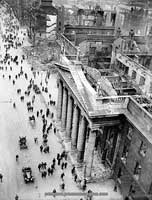
The GPO in Dublin was the center of the 1916 Easter insurrection.
|
| |
The
insurrection lasted for a week and caused total devastation
to the center of Dublin.
In
the U.S., the insurrection won sympathy for the British
as it was viewed as a "stab in the back" while
they were dying by the thousands in the trenches.
|
|
|
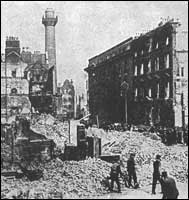
Total devastation after the
Easter insurrection. |
Here
is an excerpt from a recent book entitled: England's Greatest
Spy: Éamon de Valera:
A
New York Times editorial dated May 4, reflected the prevailing public
opinion regarding the Irish insurrection: "War is a stern business
and the subject who sets himself against the Government when the
nation is straining every resource to overcome enemies in the field,
can hardly expect mercy ... The ally at home of the enemy abroad
confesses himself a traitor....Great Britain is engaged in a terrible
war, of which the end is not yet in view. It can hardly be doubted
that in like circumstances, any other Government would, in like
manner, have enforced the law in its full rigor."
Britain's very existence hung in the balance. The Irish failed to
understand that the British, in allowing the insurrection to take
place, were after bigger game - American public opinion and to counter
John Devoy and the Irish-Americans who were engaged in orchestrating
a cacophony of protests designed to rupture Anglo-American relations.
The American people had to be persuaded to enter the war on the
side of England and the Allies. (Turi, England's
Greatest Spy: Éamon
De Valera, pp. 71-72).
The
timing of this insurrection was everything. It was just when British
spies in the U.S. were mounting a major campaign to drag the U.S. into
the war.
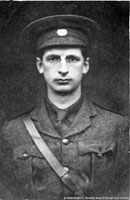
Éamon de Valera (1882–1975)
as battalion commander. |
| |
Sinister
MI5 spy Éamon de
Valera was one of the ringleaders of the insurrection.
All
the other leaders of the insurrection were shot . . . except
for de Valera.
|
|
|
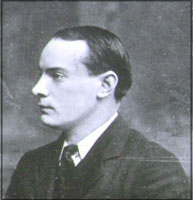
Patrick Pearse (1879 - 1916) was the
overall leader of the insurrection. |
For the leader
of a major insurrection, de Valera led a charmed existence. After the
insurrection, he was sent to Lincoln Jail in England. He had a more
miraculous escape from prison than St. Peter. A visitor smuggled in
a key to his cell in a cake and then the iron gates to the prison seemed
to open miraculously.
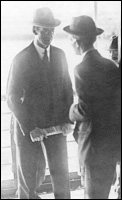
De Valera conferring with his
fellow spy Erskine Childers. |
| |
In 1922,
Childers was arrested as a spy by the Irish "Republican"
Army, and put before a firing squad.
His
famous last words to the firing squad were: "Take
a step forward lads, it'll be easier that way."
His
fellow spy de Valera survived and went on to found a clerical
"Republic."
|
|
|
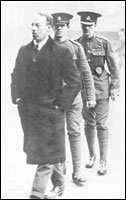
Childers was arrested and
shot by the IRA in 1922. |
It is a miracle
indeed that de Valera survived the Easter insurrection, the following
Civil War, and all the bloody assassinations and reprisals that followed
the founding of that "Republic."
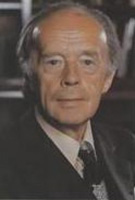
Erskine H. Childers (1905–1974) was the
3rd president of the clerical "Republic." |
| |
Erskine Hamilton
Childers, son of the executed Erskine, was the 3rd president
of the British Empire "Republic."
De
Valera was a towering figure in the clerical "Republic"
who dominated Irish politics from 1916 until his death
in 1975. |
|
|

Éamon de Valera was the 4th
president of the clerical "Republic." |
De
Valera set up a totalitarian "Republic" totally dominated
by the Latin hierarchy. The closest example of such a "Republic"
today is the Islamic "Republic" of Iran.

Cardinal D'Alton (right) and the Archbishop of Dublin, Dr McQuaid,
seen off at Dublin airport by de Valera on their way to Rome in
1962. |
| |
The Latin
hierarchy completely dominated de Valera's "Republic."
The
closest example today is the Islamic "Republic"
of Iran. |
|
|
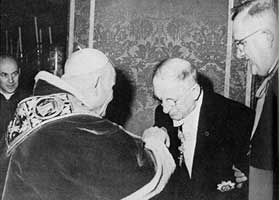
De Valera kissing the ring of
Pope John XXIII. |
More
sinister still, in 1929 de Valera's "Republic" was the first
country to recognize the newly created Vatican City State.
The
Irish "Republic" was the first to recognize Vatican City
State!!
It
is beyond belief that the Irish "Republic" was the
first country to recognize Vatican City State.
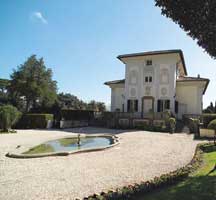
Vatican Embassy in Dublin.
|
| |
Rome has
2 embassies in Dublin.
It
is beyond belief that the Irish "Republic"
was the first country to recognize Vatican City State.
The
Papacy is an absolute monarchy and the deadly enemy
of all true Republics.
|
|
|

Italian Embassy in Dublin. |
MI5
and MI6 would love to have a Vatican Embassy in London but Great Britain
still has some Christians left who might strenuously object. A great
location for the Vatican Embassy would be right next to MI6 headquarters!!
Vital
Links
References
Durey,
Michael, William Wickham, Master Spy: The Secret War Against the
French Revolution. Pickering & Chato, London, 2009.
Childers,
Erskine.
The Riddle of the Sands.
Smith Elder, London, 1903. Republished by the Naval Institute Press,
Annapolis, Maryland, 1991.
Coogan,
Tim Pat. Éamon De Valera. The Man Who Was Ireland.
HarperCollins Publishers. New York, 1993.
Geoghegan,
Patrick M. The Irish Act of Union. A Study in High Politics 1798-1801.
St. Martin's Press, New York, 1999.
Meredith,
Martin. Diamonds,
Gold, and War: the British, the Boers, and the Making of South Africa.
PublicAffairs, New York, 2007.
Piper,
Leonard. Dangerous Waters. The Life and Death of Erskine Childers.
Hambledon & London, London, 2003.
Turi,
John J. England's
Greatest Spy: Éamon
De Valera. Stacey International, London, 2011.
Wilkinson,
Burke. The Zeal of the Convert. The Life of Erskine Childers.
Second Chance Press, Sag Harbor, New York, 1976.
Copyright
© 2013 by Patrick Scrivener
Back to Main
Menu |




























